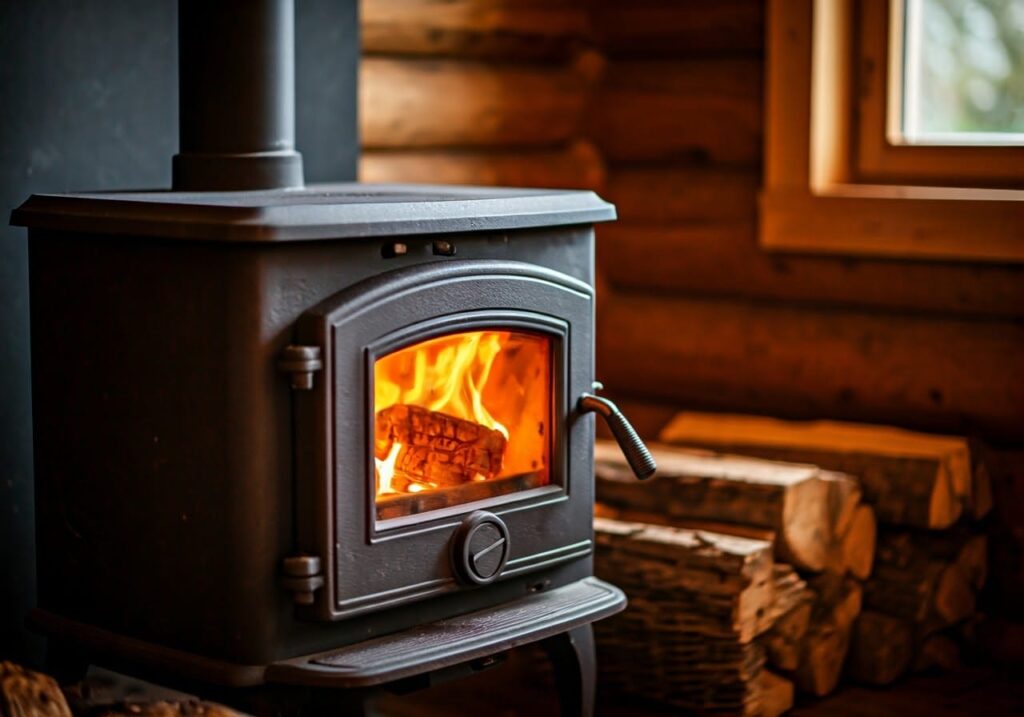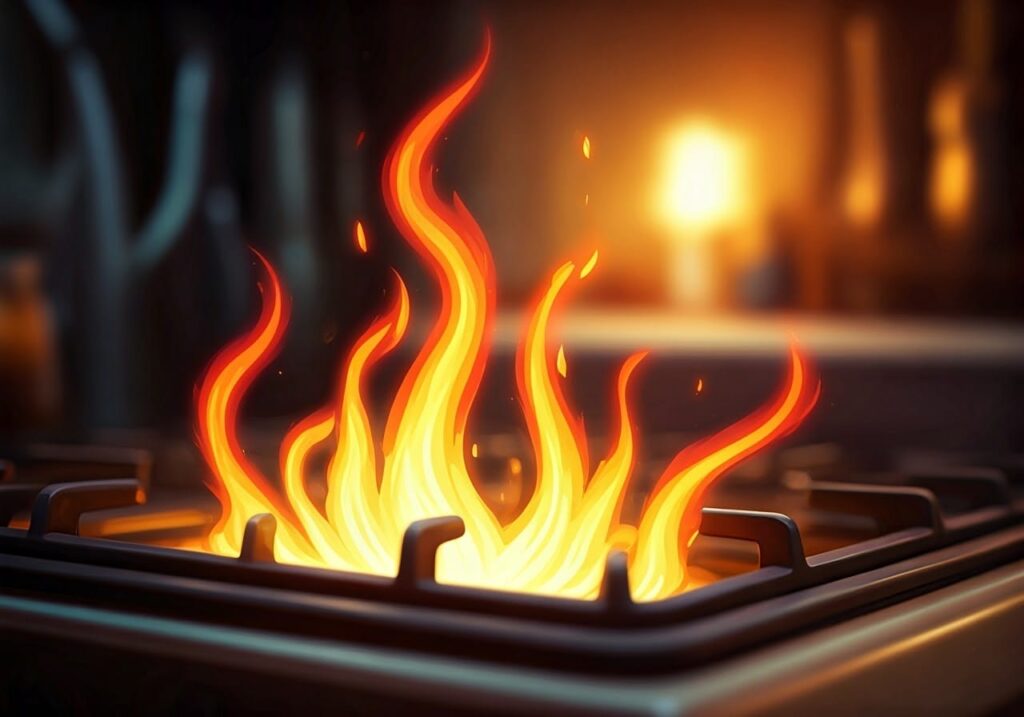
Warmth of Tradition: Understanding Wood-Burning Stoves
As the crisp autumn air sets in, and the winter months loom on the horizon, the allure of a crackling wood-burning stove becomes increasingly irresistible. For centuries, these traditional heating solutions have provided warmth, comfort, and a sense of nostalgia to homes worldwide. Beyond their rustic charm, modern wood-burning stoves have evolved to offer a sustainable, cost-effective alternative to conventional heating methods. But have you ever stopped to think about the intricacies of how wood-burning stoves work? From the science behind the combustion process to the importance of proper installation, there’s more to these heaters than meets the eye.
Listen to our Podcast on How They Work
In this comprehensive guide, we’ll delve into the fascinating world of wood-burning stoves, exploring the heating process, key components, efficiency, and more. Whether you’re a seasoned user, a curious newcomer, or simply considering embracing the warmth of a wood-burning stove, this guide is tailored to enlighten and inform.
The Heating Process: How Does a Wood-Burning Stove Heat Your Home?
Read the In-Depth Guide: How Does a Wood-Burning Stove Heat Your Home?
Imagine settling into your favorite armchair on a chilly winter evening, surrounded by the warm, golden glow of your wood-burning stove. As the flames dance and the heat radiates, have you ever wondered about the remarkable journey of how this warmth is generated? The heating process of a wood-burning stove is a symphony of science and technology, where each note plays a crucial role in creating the perfect harmony of warmth. From the initial spark that ignites the wood to the final wisps of heat that caress your home, understanding this process is key to appreciating the full potential of your wood-burning stove. Here’s a succinct overview to get you started:
- Combustion: Wood is burned within the stove’s firebox, releasing heat.
- Heat Distribution: The generated heat is then distributed throughout your home via convection (natural circulation of air) and, in some models, assisted by fans.
- Key Components: The firebox, baffle, and chimney play crucial roles in this process. The firebox contains the combustion, the baffle ensures efficient burning by redirecting gases, and the chimney safely vents fumes outside.
Proper installation is paramount for efficient and safe heating. Ensure your wood-burning stove is installed by a certified professional to reap its full benefits.
Understanding the Inner Workings: Anatomy of a Wood Stove
Dive Deeper: Understanding the Anatomy of a Wood Stove: Key Components
Wood-burning stoves are often admired for their exterior design, but the true magic lies in their intricately designed interior. The anatomy of a wood stove is a marvel of engineering, with each component working in tandem to ensure efficient, safe, and warm operation. Just as a conductor leads an orchestra, each part of the stove plays a vital role in the symphony of heat production. Let’s take a step inside and introduce the key players:
- Firebox: The heart of the stove where combustion occurs.
- Baffle: Enhances efficiency by ensuring complete combustion of gases.
- Chimney: Safely directs fumes and particles outside.
Each component plays a critical role in the stove’s overall efficiency and safety. For a detailed exploration of these and other key parts, delve into our anatomy guide.
Deciphering Wood Stove Efficiency: What You Need to Know About BTUs
Explore Further: Wood Stove Efficiency: What You Need to Know About BTUs
In the quest for the perfect wood-burning stove, efficiency stands as a paramount consideration. But what lies behind the often-misunderstood metric of BTUs (British Thermal Units)? Is it merely a numbers game, or is there more to unlocking the full potential of your stove? Delving into the world of BTUs reveals a complex interplay of factors, from the type of wood you burn to the stove’s design. Here’s a primer to get you started on your journey to maximizing efficiency:
- BTU Ratings: Look for stoves with high BTU outputs for larger spaces or colder climates.
- Efficiency Factors: Wood type, moisture content, and stove maintenance significantly impact efficiency.
- Choosing Efficiently: Balance BTU needs with your space’s requirements to avoid wasting energy.
For a more in-depth look at BTUs and how to maximize your stove’s efficiency, refer to our dedicated efficiency guide.
The Role of Air Vents in Controlling Heat
Learn More: How Air Vents Control the Heat in a Wood-Burning Stove
Air vents play a crucial role in controlling the heat output of your wood-burning stove. By adjusting these vents, you can influence combustion, temperature, and efficiency. Understanding how to properly use air vents is essential for:
- Vent Control: Adjusting vents controls airflow, influencing combustion intensity and heat production.
- Optimal Adjustment: Find the sweet spot for your stove and space to minimize waste and maximize warmth.
- Safety First: Always ensure proper ventilation to avoid dangerous fume buildup.
Mastering air vent control is essential for both efficiency and safety. Explore our detailed guide for practical adjustment tips.
Step-by-Step to Warmth: Efficient Wood Stove Operation
Follow Along: Step-by-Step Guide: How to Operate a Wood Stove Efficiently
Operating a wood-burning stove efficiently requires attention to detail, but with practice, anyone can master the techniques to optimize its performance. Here’s a condensed, yet comprehensive operational guide to help you get started:
- Preparation: Ensure your stove and chimney are clean and clear.
- Ignition: Use dry, seasoned wood for optimal combustion.
- Adjustment: Monitor and adjust air vents for desired heat output.
- Maintenance: Regularly clean the stove and inspect the chimney.
Avoid common pitfalls by understanding what not to do. Our guide on top mistakes people make when using wood stoves is a valuable companion to this operational overview.
Unlocking Efficiency: What Is a Baffle in a Wood Stove and Why Is It Important?
Tucked away within the confines of your wood-burning stove lies a frequently underappreciated yet vital component: the baffle. This unassuming element plays a pivotal role in elevating your stove’s combustion efficiency, thereby amplifying its overall performance. Let’s delve into the baffle’s multifaceted significance and explore how understanding its function can revolutionize your heating experience.
The Baffle’s Triple-Threat Functionality:
- Enhanced Combustion Efficiency: By redirecting gases, the baffle ensures a more complete combustion process, resulting in:
- Increased Heat Output: More warmth for your home, courtesy of a more efficient burn.
- Reduced Emissions: A cleaner, more environmentally friendly combustion process.
- Prolonged Stove Lifespan: The baffle’s role in optimizing combustion also contributes to:
- Minimized Creosote Buildup: Reducing the risk of chimney fires and stove damage.
- Less Wear and Tear: A more efficient burn equals less stress on your stove’s components.
Design Variations: Material and Design Implications
- Material Choices: From steel to ceramic, each material influences the baffle’s performance and durability.
- Design Configurations: Different designs (e.g., flat, curved, or angled) can impact airflow and combustion efficiency.
- Customization Options: Some stoves allow for adjustable or removable baffles, offering flexibility in optimizing performance.
Heating Showdown: Wood Stoves vs. Fireplaces
Compare and Contrast: Wood Stoves vs. Fireplaces
When it comes to warming your home with the rustic charm of wood, two popular options emerge: wood-burning stoves and fireplaces. While both can provide a cozy ambiance, they differ significantly in terms of efficiency, safety, and aesthetic appeal. Let’s dive into a detailed comparison to help you make an informed decision that aligns with your priorities.
Efficiency: The Clear Winner
- Wood Stoves: Generally outperform fireplaces in heating output and efficiency, with some models achieving up to 70% efficiency.
- Fireplaces: Typically have lower efficiency ratings, often below 30%, due to heat loss through the chimney.
Safety Considerations: Containment is Key
- Wood Stoves: Often more contained, with a closed combustion system that reduces the risk of sparks and embers escaping.
- Fireplaces: Open design can increase safety risks if not properly screened or maintained.
Aesthetic Appeal: Ambiance vs. Cozy Warmth
- Fireplaces: Typically offer a more dramatic, ambient experience, with an open flame and larger viewing area.
- Wood Stoves: Provide a cozy, warm glow, with a more compact design that can be easily integrated into various room layouts.
Consider your priorities—sustainability, heating needs, and aesthetic desires—to make an informed decision.
Getting the Most Out of Your Wood Stove
Maximize Your Stove’s Potential: How to Maximize Heat Output from Your Wood-Burning Stove
To squeeze every last bit of warmth from your wood stove:
- Optimize Wood Choice: Seasoned, dry wood burns more efficiently.
- Regular Maintenance: Cleanliness is key to sustained performance.
- Chimney Care: A well-maintained chimney ensures safe and efficient operation.
Don’t overlook the importance of a clear chimney; the dangers of neglect are very real.
Avoiding the Pitfalls: Top Common Mistakes People Make
Steer Clear of Trouble: Top Common Mistakes People Make When Using Wood Stoves
Familiarize yourself with frequent mistakes to ensure a safe and efficient heating experience:
- Incorrect Installation
- Poor Wood Choice
- Neglecting Maintenance
Avoid these common errors with our detailed guide, ensuring your wood-burning stove experience is nothing but warm and comforting.
The Hidden Dangers of a Clogged Chimney
Ensure Safety: What Happens When Your Wood Stove’s Chimney Gets Clogged?
A clogged chimney poses significant risks, including:
- Carbon Monoxide Poisoning
- Fire Hazards
- Reduced Efficiency
Regular inspections and professional cleanings can prevent these dangers. Prioritize your safety and stove’s performance.
Embracing the Warmth: A Comprehensive Understanding of Wood-Burning Stoves
As we conclude this comprehensive guide, you’re now well-equipped with the knowledge to harness the full potential of your wood-burning stove. Whether you’re seeking sustainable heating solutions, efficiency tips, or simply a deeper understanding of these traditional warmth providers, this guide has been your companion every step of the way. Embrace the warmth, efficiency, and timeless appeal of wood-burning stoves, and let the comfort of a well-tended fire enrich your home and heart.
Final Thoughts for a Sustainable Tomorrow:
- Sustainable Living: Wood-burning stoves offer a renewable energy source, reducing reliance on fossil fuels.
- Efficient Heating Solutions: Proper use and maintenance can significantly lower your carbon footprint.
- Wood Stove Appeal: Beyond functionality, they add a cozy, welcoming ambiance to any home.


